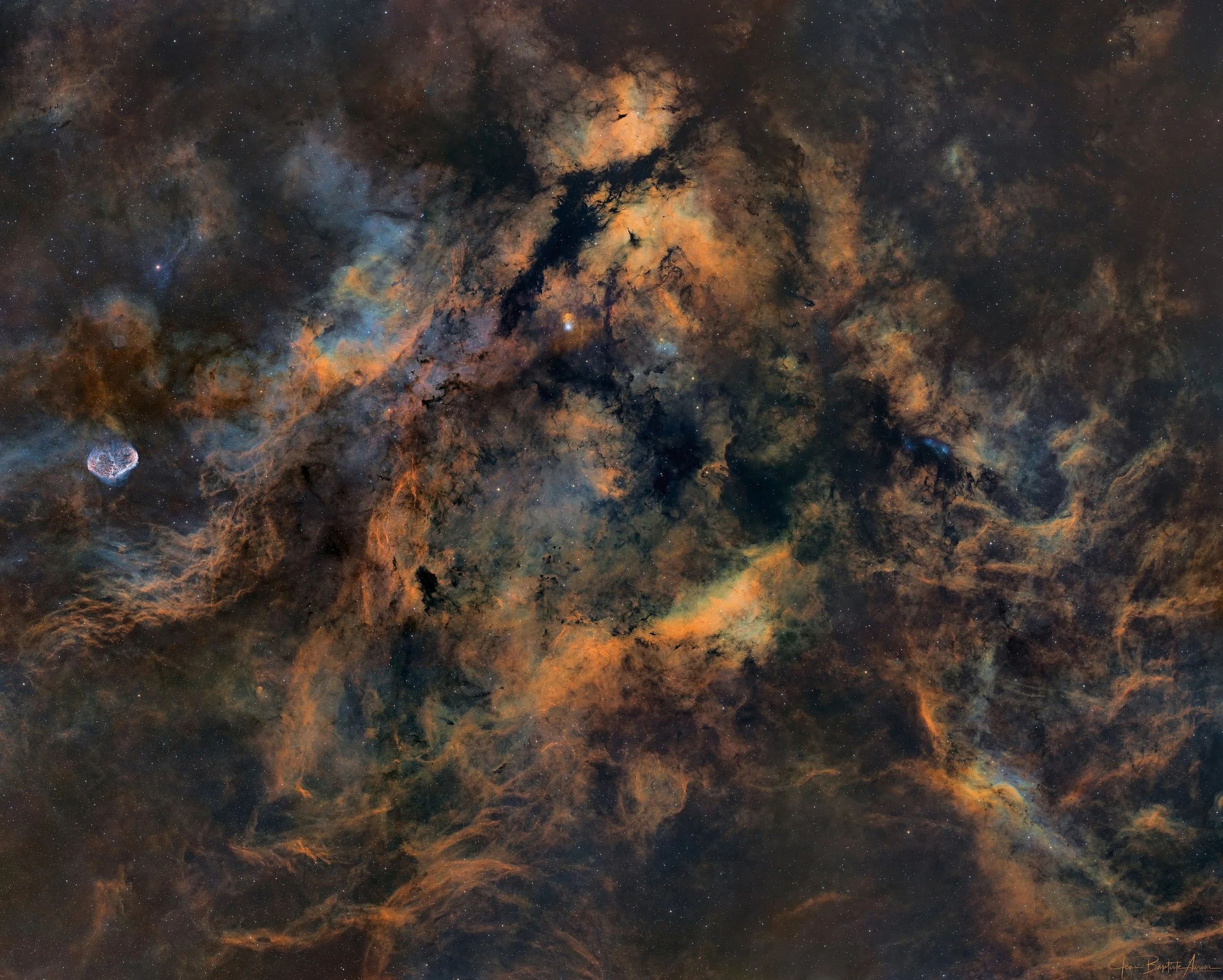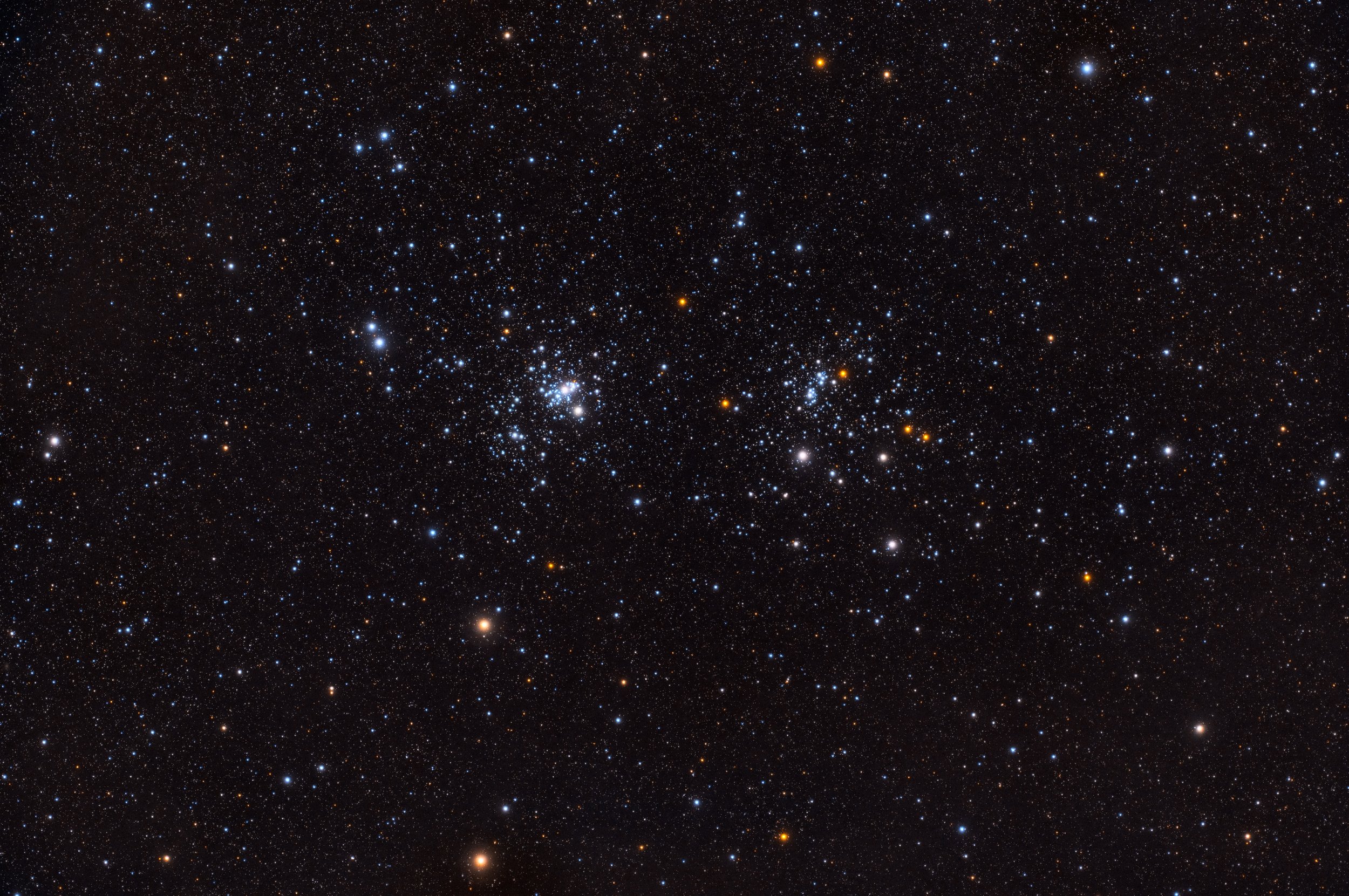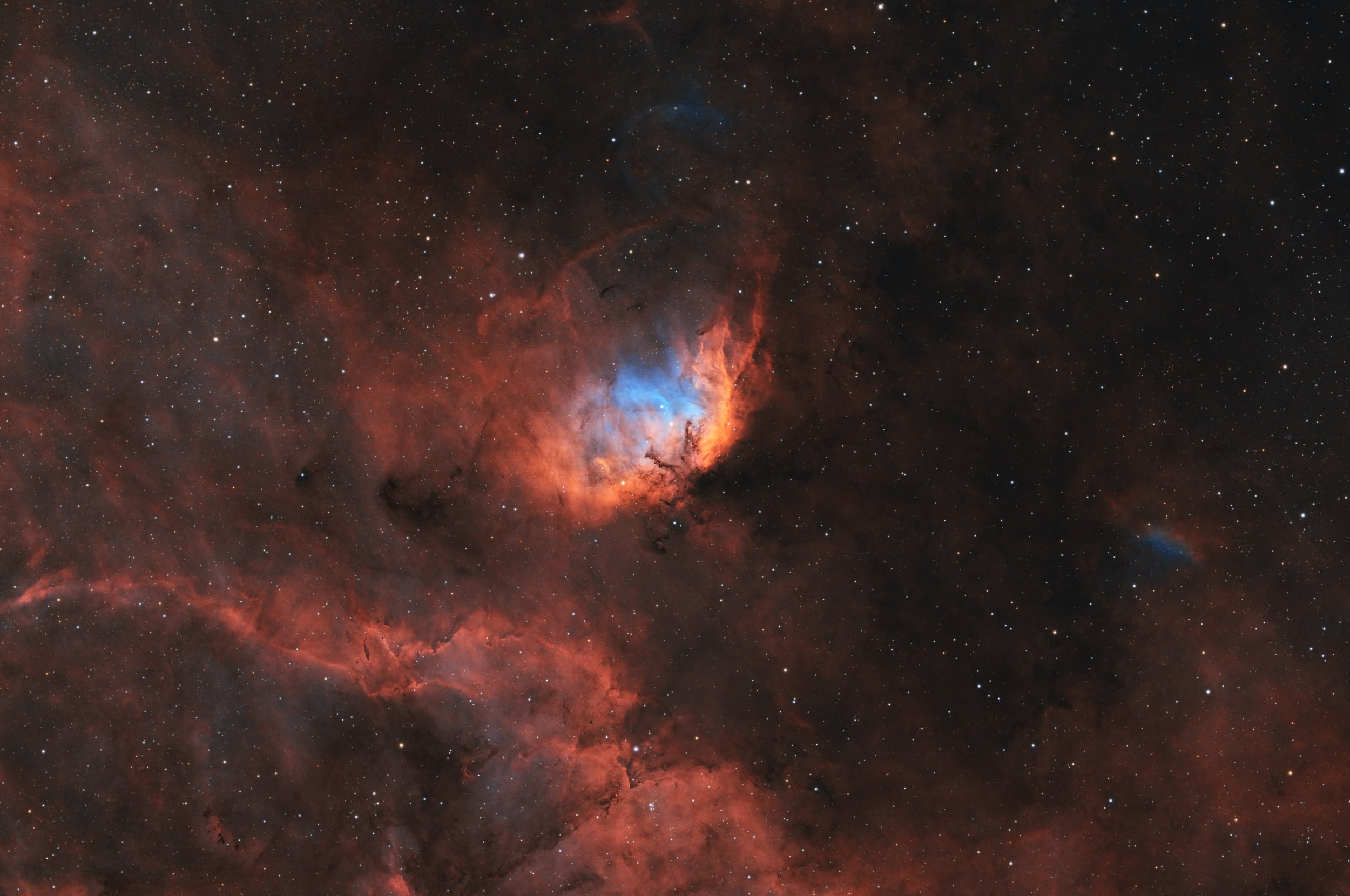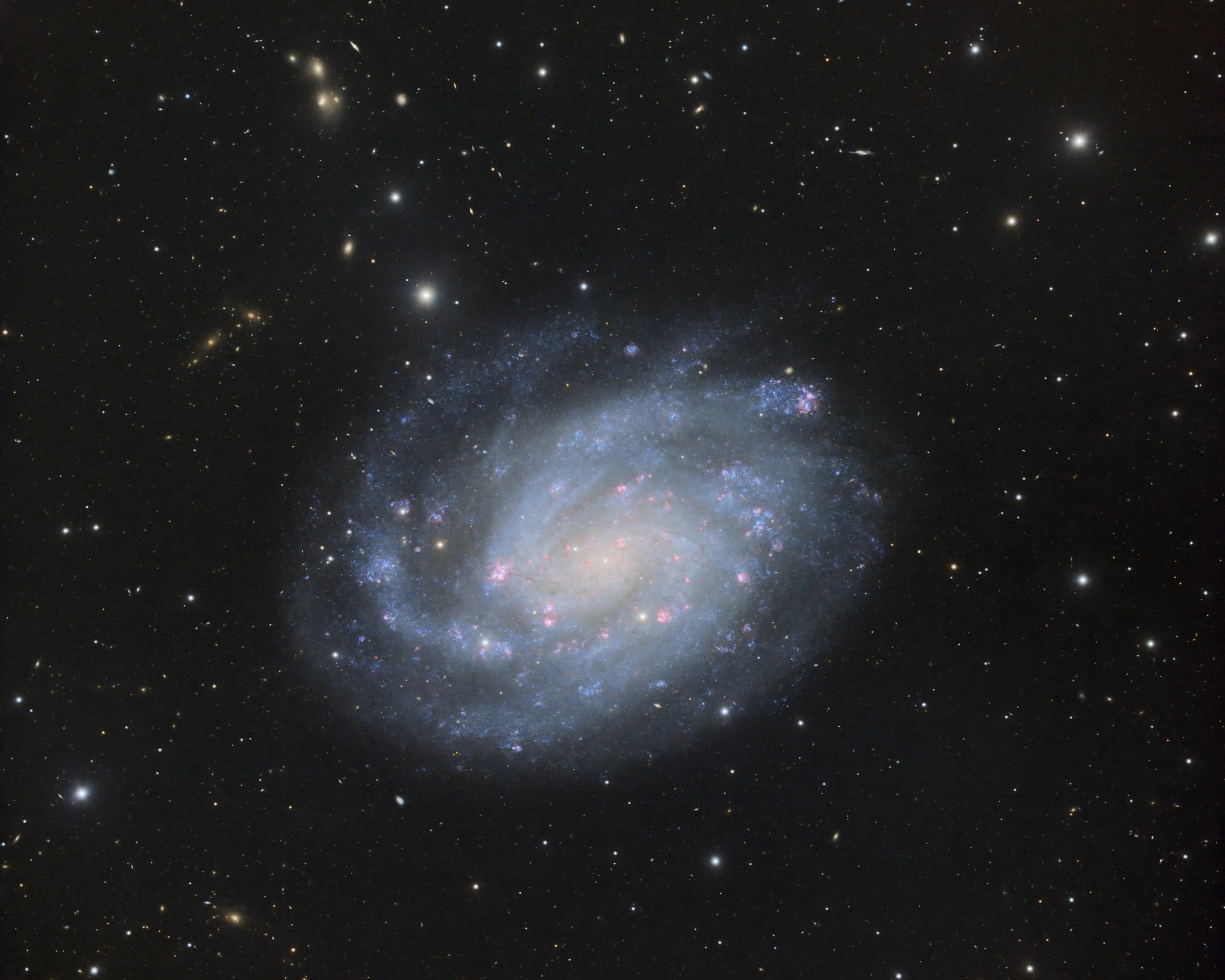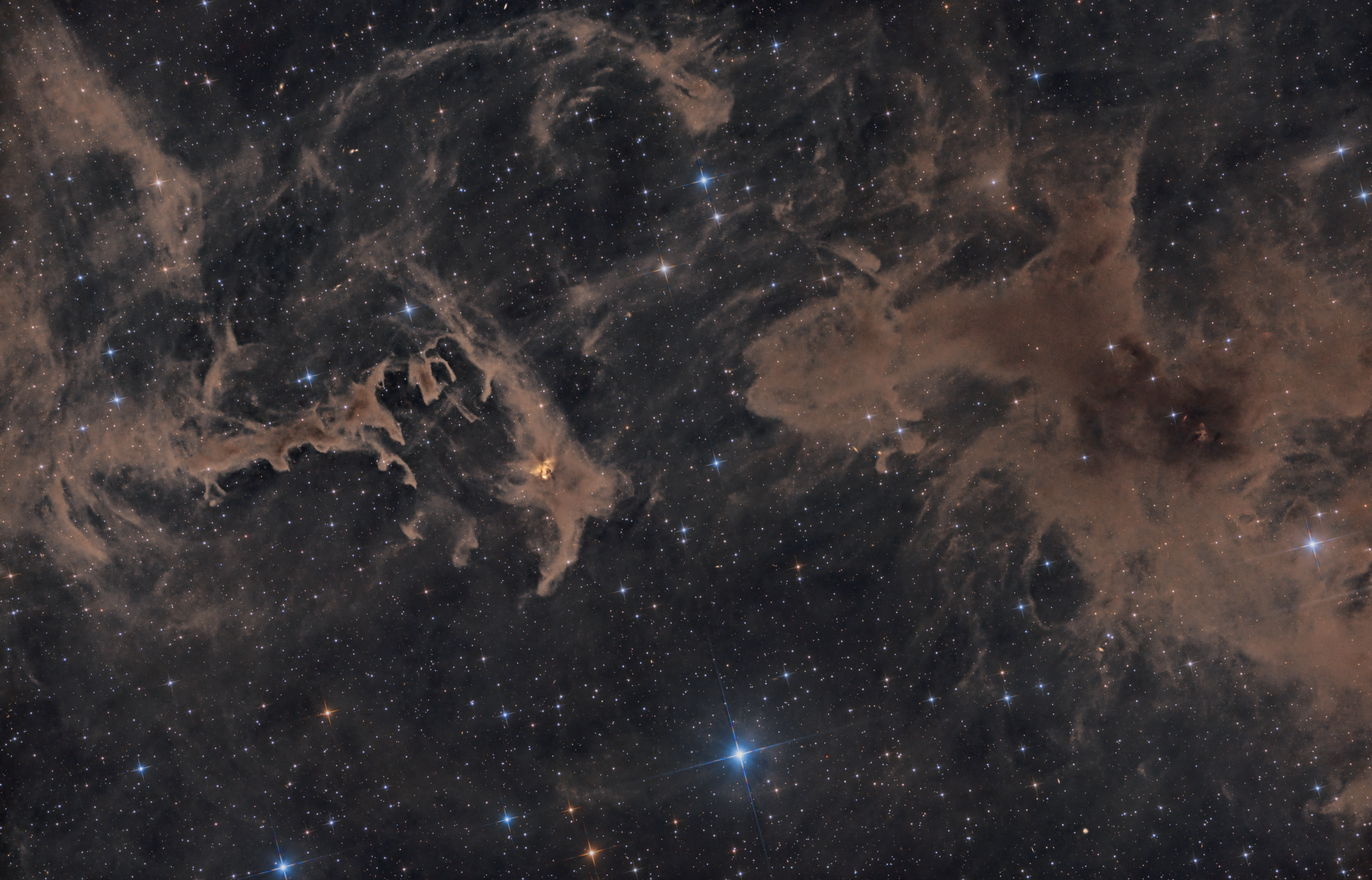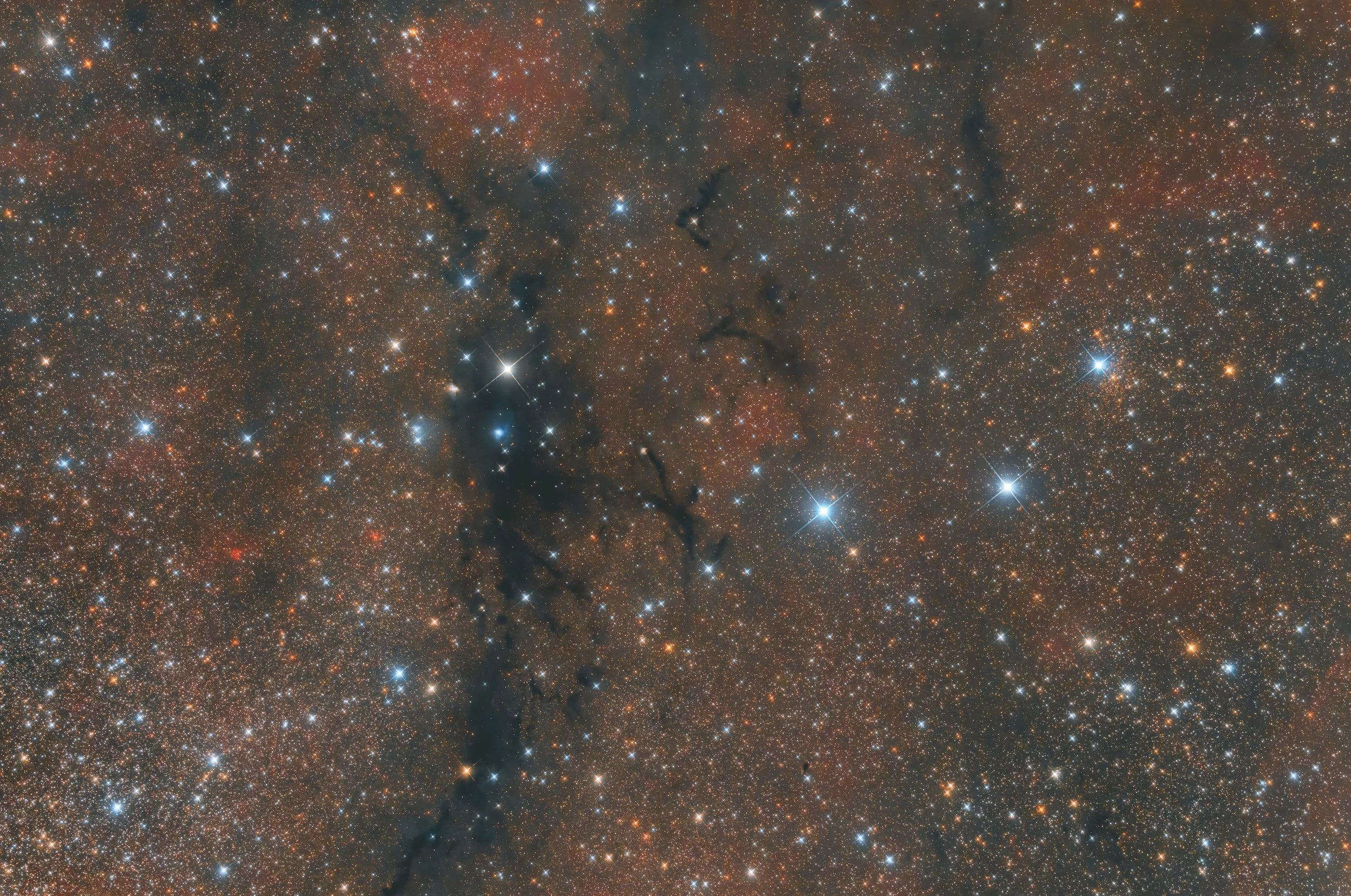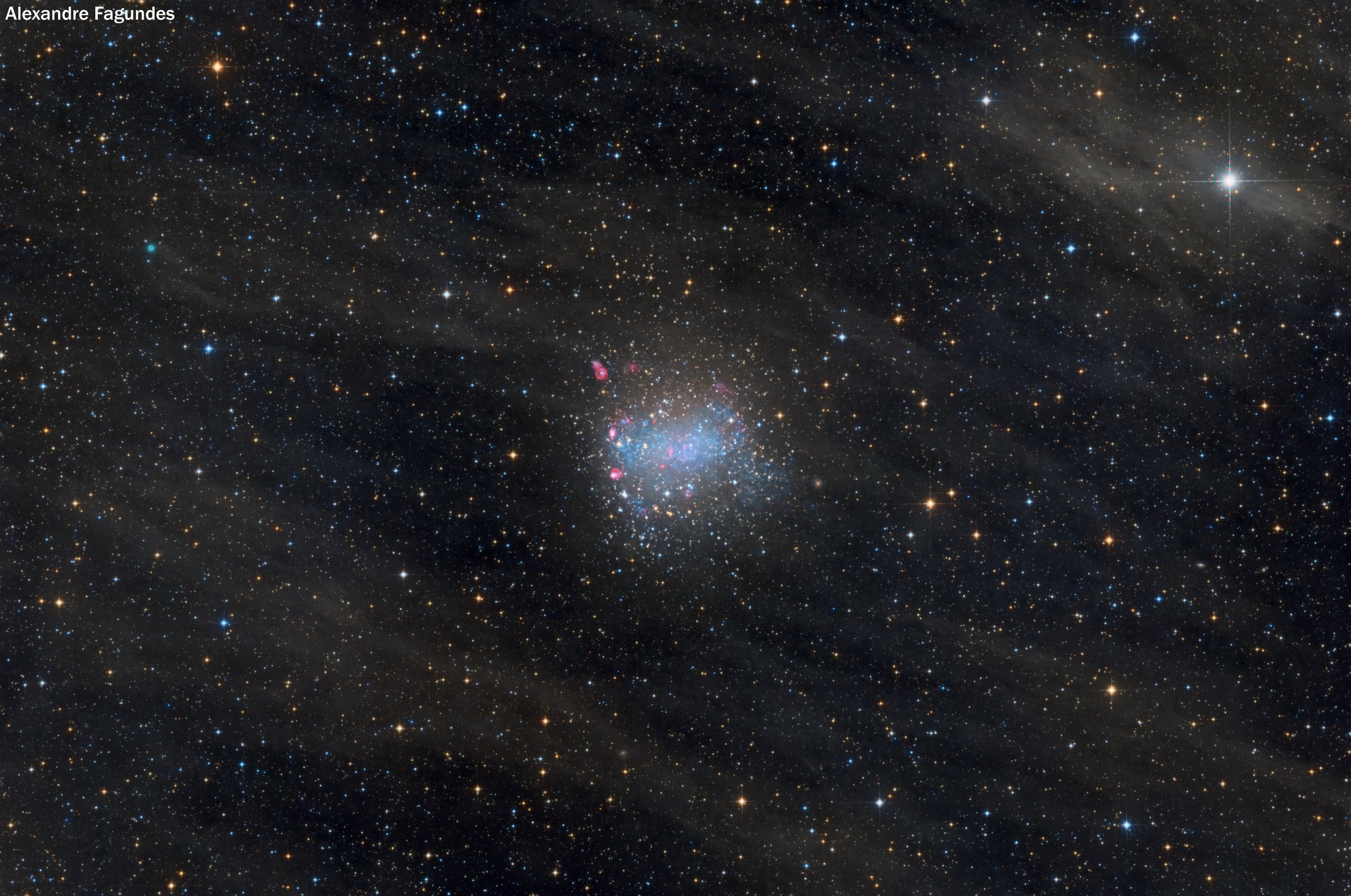
AAPOD2 Image Archives
VDB 141 The Ghost Nebula
VdB 141, also known as the Ghost Nebula, is a hauntingly beautiful reflection nebula situated in the constellation Cepheus. This celestial apparition gets its name due to its ghostly, ethereal appearance, as it appears to be a faint, shimmering cloud against the dark backdrop of space.
In this striking image, VdB 141 is bathed in the soft glow of starlight, which is scattered and reflected by dust grains within the nebula. This creates a captivating blue haze that envelopes the nebula, making it seem almost like a phantom in the cosmic night. The nebula is a stellar nursery where new stars are born.
HFG1 & Abell 6
HFG 1, also known as Abell 6, is an intriguing planetary nebula located in the constellation Lynx. Planetary nebulae are shells of gas and dust ejected by dying stars, and they often exhibit unique and captivating shapes. HFG 1 is no exception and offers a remarkable cosmic spectacle.
In this image, HFG 1 and Abell 6 come to life, revealing their intricate and alluring features. HFG 1, the central object, showcases its intricate, lacy structure with a central star at its heart. Surrounding it, Abell 6 is a faint, circular shell of gas, representing the outer layers of a star that were expelled during its final stages of evolution.
NGC 253 - the Sculptor Galaxy
The Sculptor Galaxy, NGC 253, is a magnificent spiral galaxy that graces our night sky from the constellation Sculptor. Its remarkable beauty lies in its intricate spiral arms, which swirl with bright, young stars and cosmic dust lanes. Located about 11 million light-years away, this galaxy's central region harbors intense star formation, evident in the luminous clusters of blue, while the surrounding arms stretch out gracefully like a cosmic pinwheel. The Sculptor Galaxy's visual appeal and proximity make it a favorite target for both amateur and professional astronomers seeking to unravel the mysteries of our universe.
Sadr region (100h / 9 panels mosaic)
The Sadr Region within the Cygnus constellation, remains an overlooked celestial gem. It's a place where dark nebulae, cosmic dust veils, and radiant stars come together to create a cosmic spectacle. At its heart lies the Sadr Nebula, a masterpiece casting a glow upon its surroundings, concealing the fascinating processes of stellar birth, where gigantic stars like Deneb emerge, illuminating the area.
What's often kept in the shadows is the Sadr Region's unique placement along the enigmatic Cygnus Rift—a colossal dark lane of molecular clouds and celestial debris that obscures our view of the Milky Way's galactic center, adding an air of cosmic intrigue. Rich in cultural and mythological significance through the ages, the Sadr Region invites us to embark on a celestial journey, reminding us that even in the lesser-known corners of the night sky, we find stories of creation, beauty, and cosmic wonder waiting to be explored.
The countless nebulae of M31
While the Andromeda Galaxy, or M31, is celebrated as our Milky Way's nearest spiral neighbor, there are intriguing lesser-known aspects to this cosmic wonder. Recent measurements hint that Andromeda might be a bit closer than the widely quoted 2.5 million light-years, emphasizing the ever-evolving nature of our astronomical knowledge.
Andromeda's invisible halo of dark matter, its history of galactic cannibalism, and its impending collision with the Milky Way in about 4.5 billion years add layers to its mystique. Within its vast expanse lie ancient star clusters, older than their Milky Way counterparts, offering insights into the early cosmos. Beyond its beauty, M31 harbors a universe of secrets, making it an enduring subject of astronomical wonder.
Venus
Venus, often referred to as Earth's "sister planet" due to its similar size and composition, harbors some lesser-known intriguing facts. Unlike most planets in our solar system, Venus rotates in a retrograde motion, meaning it spins clockwise on its axis, opposite to the direction of its orbit around the Sun. This unusual rotation results in extremely long Venusian days, lasting longer than its years. Venus also boasts one of the most hostile environments in our solar system, with surface temperatures hot enough to melt lead and crushing atmospheric pressure akin to being 3,000 feet underwater. Furthermore, Venus has a mysterious phenomenon known as "super-rotational winds," where its thick cloud cover rotates much faster than the planet's surface, with winds reaching speeds of up to 224 miles per hour (360 kilometers per hour). These enigmatic features make Venus a captivating but challenging celestial neighbor to explore.
NGC 869 & NGC 884 - The Double Cluster
The Double Cluster, also known as Caldwell 14, is one of the most prominent and captivating open star cluster pairings in the night sky. Located in the constellation Perseus, these clusters are relatively young, with an estimated age of around 12.8 million years. What makes them particularly fascinating is that they are not physically associated with each other, despite their apparent proximity in the night sky. NGC 869, the northern cluster, is about 6,800 light-years away from Earth, while NGC 884, the southern cluster, is approximately 7,500 light-years away. This intriguing separation highlights the optical illusion of their proximity and adds a layer of complexity to their celestial beauty.
Rotation of Jupiter and Io
This mesmerizing animation captures the celestial ballet between Jupiter, the largest planet in our solar system, and its volcanic moon, Io. In this GIF, Jupiter's massive gaseous sphere slowly rotates, revealing its intricate cloud bands and swirling storms, while Io, the innermost of Jupiter's Galilean moons, orbits gracefully in close proximity. This dynamic display showcases the intricate interplay of gravitational forces and celestial mechanics, offering a vivid glimpse into the captivating dance of celestial bodies in the cosmos.
Bat Out of Hell - Fire and Brimstone Edition AKA (The Eastern Veil)
The Eastern Veil Nebula, also known as NGC 6992, is a spectacular celestial spectacle that comes to life in this captivating narrowband image. Located in the constellation Cygnus, this intricate nebula is a remnant of a supernova explosion that occurred thousands of years ago, carving out a mesmerizing cosmic tapestry.
In this narrowband view, the image highlights the delicate filaments and tendrils of the Eastern Veil Nebula, which are rich in hydrogen-alpha, sulfur, and oxygen emissions. These specialized filters reveal the nebula's intricate structure and intricate details, with vibrant hues of red, green, and blue.
Luna mineral creciente
This RGB image of a Waxing Crescent Moon showcases the lunar surface in all its mineral-rich glory. The Moon, Earth's celestial neighbor, reveals its rugged topography and diverse mineral composition in this captivating photograph. The image captures the subtle color variations and features of the lunar landscape, allowing us to appreciate the Moon's unique geological characteristics.
In this view, the Moon's surface displays shades of gray, brown, and hints of other mineral colors, reflecting the diverse composition of rocks and regolith that make up its surface. This Waxing Crescent Moon, illuminated by the soft glow of the Sun, offers a mesmerizing glimpse into the lunar terrain, reminding us of the geological history and mysteries that continue to intrigue scientists and inspire sky gazers worldwide.
SH2-101 Tulip Nebula
In this striking narrowband image captured in the Hubble Palette, Sh2-101, also known as the Tulip Nebula, unveils its cosmic beauty in vivid and ethereal colors. Nestled in the constellation Cygnus and situated approximately 6,000 light-years away from Earth, the Tulip Nebula showcases its intricate structure in a palette that emphasizes specific emissions from hydrogen, sulfur, and oxygen gases.
The image reveals the petals of the Tulip Nebula, with vibrant shades of red, green, and blue, created by the interplay of these elemental gases under the intense radiation of nearby stars. This cosmic scene, presented in the Hubble Palette, serves as a testament to the remarkable beauty and complexity of the universe, where the celestial canvas is painted with the brushstrokes of light, matter, and cosmic forces.
NGC 300 - an obliquely angled spiral galaxy in Sculptor
NGC 300, a distant galaxy residing in the southern constellation Sculptor.. This spiral beauty, located approximately 7 million light-years away from Earth, is a breathtaking testament to the vastness of our universe. In this captivating image, NGC 300 unveils its intricate structure, with graceful spiral arms adorned with clusters of brilliant stars.
The galaxy's soft glow is a reminder of the countless stars that populate its disk, where new stars continue to be born amidst the interstellar dust and gas. NGC 300 is a celestial masterpiece, a mosaic of light and color that offers a profound glimpse into the mysteries of the cosmos.
Milky Way on Nivolet
Under the pristine skies of Nivolet, the Milky Way unfurls its resplendent splendor in this captivating landscape image. Nivolet, known for its pristine natural beauty, provides an ideal backdrop for gazing into the cosmic abyss. In this enchanting photograph, the luminous band of our galaxy stretches majestically across the night sky, casting a gentle glow upon the serene landscape below.
As the Milky Way's countless stars twinkle overhead, they reflect in the tranquil waters of Nivolet, creating a mesmerizing mirror effect that blurs the boundary between Earth and the cosmos. The surrounding landscape, bathed in the soft light of the night, adds to the enchantment, highlighting the harmony between the earthly and the celestial. This image is a testament to the timeless beauty and wonder that awaits those who venture into the heart of nature to witness the grandeur of the Milky Way above Nivolet.
LBN 552 and LDN 1228
LBN 552 and LDN 1228, a celestial pairing that contrasts light and darkness in the cosmos, come together in this striking image. LBN 552, an emission nebula, stands as a beacon of stellar birth and brilliance, while LDN 1228, a dark nebula, conceals the secrets of cosmic obscurity. Located in the constellation Cepheus, these nebulous regions reveal the intricate interplay of light and shadow in the universe.
In this captivating view, the image unveils the exquisite details of both LBN 552 and LDN 1228, showcasing the radiant reds and blues of the emission nebula juxtaposed against the inky blackness of the dark nebula.
SH2-120
Sh2-120, a celestial gem hidden within the vastness of space, reveals its stunning beauty in this OSC image. Nestled in the constellation Cepheus, this emission nebula is a captivating testament to the cosmic forces at play. Located approximately 6,000 light-years away from Earth, Sh2-120 is a stellar nursery where new stars are born from the surrounding interstellar gas and dust. In this exquisite view. The image showcases the delicate balance of reds, pinks, and blues in Sh2-120, offering a glimpse into the dynamic and ever-evolving tapestry of our universe. This celestial wonder serves as a reminder of the ongoing cosmic drama, where stars are born and the cosmos continually reshapes itself in a breathtaking display of celestial artistry.
IC 1848 (AKA Soul Nebula, Embryo Nebula or W5)
The Soul Nebula, also known as IC 1848, shines with captivating brilliance when viewed through narrowband filters that isolate specific wavelengths of light. This celestial masterpiece, located in the constellation Cassiopeia and approximately 6,500 light-years away from Earth, unveils its ethereal beauty in this narrowband image. The specialized filters emphasize the emissions from ionized hydrogen and oxygen, highlighting the intricate tendrils and glowing clouds of the nebula in stunning detail. In this cosmic portrait, the Soul Nebula's radiant pinks and deep reds come to life, revealing a celestial dreamscape where new stars are born amidst the interstellar clouds. This narrowband view of the Soul Nebula offers a mesmerizing glimpse into the hidden wonders of the universe, where the dance of light and gas paints a masterpiece that transcends both time and space.
The Barnard Galaxy (NGC 6822)
NGC 6822, affectionately known as Barnard's Galaxy, is a small, irregular dwarf galaxy situated in the constellation Sagittarius. Despite its modest size, this celestial gem has captivated astronomers with its intricate structure and stellar richness. Lying about 1.6 million light-years away from our Milky Way, NGC 6822 is considered a satellite galaxy of our own, orbiting the larger Milky Way. Its irregular shape is the result of gravitational interactions with its host galaxy. Within its boundaries, NGC 6822 hosts a diverse population of stars, from young, hot, blue stars to older, cooler, reddish stars, making it a valuable object of study for understanding the evolution of galaxies and the birth and life cycles of stars. This distant galaxy continues to reveal its secrets to astronomers and serves as a testament to the diverse and wondrous objects that populate our cosmic neighborhood.
NGC 7635 Bubble Nebula deep close-up
The Bubble Nebula, designated NGC 7635, is a stunning celestial wonder located in the constellation Cassiopeia. This breathtaking emission nebula is a region of active star formation, where massive stars at the center emit intense ultraviolet radiation, causing the surrounding gas to glow brilliantly. What makes the Bubble Nebula particularly captivating is its spherical, bubble-like structure, created by the powerful stellar winds and radiation from a central massive star known as BD+60°2522. This stellar wind compresses the surrounding interstellar material, sculpting the gas and dust into a shell-like form. The Bubble Nebula is a visual testament to the dynamic interplay between massive stars and the cosmos, offering astronomers a glimpse into the ongoing birth and evolution of stars in our Milky Way galaxy.
Saturn Tethys & Dione
Saturn's captivating moon system includes Tethys and Dione, two intriguing worlds of icy beauty. Tethys, the fifth-largest moon of Saturn, boasts a diameter of around 1,060 kilometers (660 miles). Named after the Greek Titan Tethys, it features the colossal Odysseus crater, spanning approximately 450 kilometers (280 miles). Tethys is further distinguished by mysterious reddish-brown streaks known as 'tiger stripes' that adorn its surface. Meanwhile, Dione, Saturn's fourth-largest moon, with a diameter of about 1,123 kilometers (698 miles), exhibits striking wispy cliffs, thought to be icy fractures. Discovered by Giovanni Domenico Cassini in 1684 and named after the Titan Dione from Greek mythology, these moons have been the focus of scientific exploration, including missions like Cassini-Huygens, which unraveled their secrets and unveiled their unique features.
New Noise in Subaru (m45: aka Pleiades)
M45, commonly known as the Pleiades or the Seven Sisters, is one of the most enchanting open star clusters in the night sky, located in the constellation Taurus. This celestial jewel, situated about 440 light-years away from Earth, is a captivating sight that has fascinated stargazers and storytellers for centuries. In this mesmerizing image, the delicate, blue-hot stars of the Pleiades cluster shine brightly against a backdrop of cosmic dust and gas, creating a celestial spectacle that never fails to inspire awe. The Pleiades have been celebrated in cultures around the world, and their presence in the night sky serves as a timeless reminder of the beauty and wonder that the universe has to offer.




